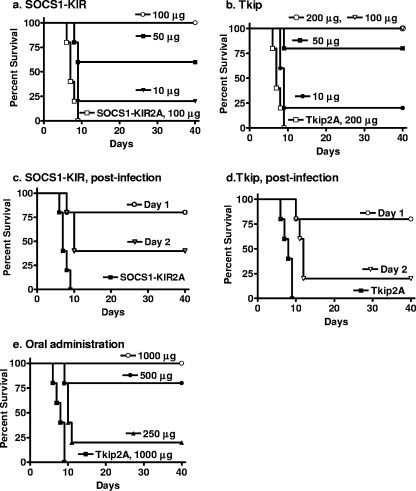FIG. 5.
SOCS1-KIR and Tkip protect mice against intranasal challenge with vaccinia virus. (a) SOCS1-KIR. Mice (C57BL/6, n = 5 per group in all mouse experiments) were pretreated i.p. on days −2, −1, and 0 with 100 μg (○), 50 μg (▪), or 10 μg (▾) of lipo-SOCS1-KIR peptide or 100 μg (□) of control peptide lipo-SOCS1-KIR2A. On day 0, vaccinia virus (2 × 106 PFU) was administered intranasally. Survival of mice was followed for 40 days. The significance of differences between different treatments was measured by the log rank survival method, which gave P values of 0.002, 0.002, and 0.005 for the administration of 100, 50, and 10 μg of lipo-SOCS1-KIR versus the control peptide, respectively. (b) Tkip. Mice were pretreated on days −2, −1, and 0 with 200 μg (○), 100 μg (▿), 50 μg (▪), or 10 μg (•) of lipo-Tkip or 200 μg of the lipo-Tkip2A control (□). Infection with vaccinia virus was similar to that in panel a. Postinfection treatment with lipo-SOCS1-KIR or lipo-Tkip provides partial protection against vaccinia virus infection. (c) Postinfection lipo-SOCS1-KIR treatment. Mice (n = 5) were infected intranasally with 2 × 106 PFU of vaccinia virus on day 0. Starting at day 1 (○) or 2 (▿) after infection, mice were treated i.p. with 200 μg of lipo-SOCS1-KIR for 3 consecutive days. Control peptide lipo-SOCS1-KIR2A (▪) at 200 μg was administered on days −2, −1, and 0. Survival was followed for 40 days. P values for the significance of differences between lipo-SOCS1-KIR treatment on days 1 and 2 versus the control peptide lipo-SOCS1-KIR2A were 0.002 and 0.005, respectively. (d) Postinfection lipo-Tkip treatment. Mice were infected with vaccinia virus in a manner similar to that described for panel a. Starting at day 1 (○) or 2 (▿) after infection, mice were treated i.p. with 200 μg of lipo-Tkip for 3 consecutive days. Control peptide lipo-Tkip2A (▪) at 200 μg was administered on days −2, −1, and 0. Survival was followed for 40 days. P values for the significance of differences between lipo-Tkip treatment on days 1 and 2 versus the control lipo-Tkip2A were 0.002 and 0.005, respectively. (e) Oral treatment with lipo-Tkip protects mice against intranasal challenge with vaccinia virus. Mice (n = 5) were given 1,000 μg (○), 500 μg (•), or 250 μg (▴) of lipo-Tkip on days −2, −1, and 0 by the oral route. One thousand micrograms of a control peptide, lipo-Tkip2A (▪), was given orally on the same days. On day 0, 2 × 106 PFU of vaccinia virus was administered intranasally. Survival of mice was followed for 40 days. P values for the significance of differences between 1,000, 500, and 250 μg of lipo-Tkip and the control peptide were 0.002, 0.008, and 0.008, respectively.

